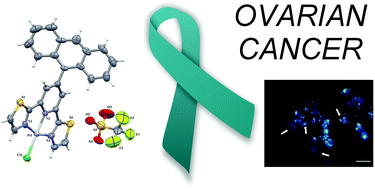Platinum(ii) complexes showing high cytotoxicity toward A2780 ovarian carcinoma cells†
Abstract
2,6-Bis(thiazol-2-yl)pyridines functionalized with 9-anthryl (L1), 9-phenanthryl (L2), and 1-pyrenyl (L3) groups were used for the preparation of [Pt(Ln)Cl]CF3SO3 (1–3). The constitution of the Pt(II) complexes was determined by 1H and 13C NMR spectroscopy, HR-MS spectrometry, elemental analysis and X-ray analysis (for (1)). The electrochemical and photophysical properties of [Pt(Ln)Cl]CF3SO3 were compared with the behaviour of the Pt(II) complexes with aryl-substituted 2,2′:6′,2′′-terpyridine ligands. What is noteworthy is that the coordination ability of dtpy toward the Pt(II) centre was investigated for the first time. All complexes were tested in vitro by MTS assay on four tumor cell lines, A2780 (ovarian carcinoma), HTC116 (colon rectal carcinoma), MCF7 (breast adenocarcinoma), and PC3 (prostate carcinoma) and on normal primary fibroblasts. Compounds (1–3) showed a dose dependent antiproliferative effect in the A2780 cell line with (3) > (2) > (1) and this loss of A2780 cell viability was due to a combination of an apoptotic cell death mechanism via mitochondria and autophagic cell death. Exposure to IC50 concentration of (2) induced an increase in the number of apoptotic nuclei and a depolarization of the mitochondrial membrane which is consistent with the induction of apoptosis while exposure to IC50 concentration of (3) showed an increase in the apoptotic nuclei with a slight hyperpolarization of the mitochondrial membrane that might indicate an initial step of apoptosis induction. The complexes (2) and (3) induce an increase in the production of intracellular ROS which is associated with the trigger of the apoptotic pathways. The ROS production was augmented by the presence of oxidants and correlated with an increase of oxygen radicals. The IC50 of (2) and (3) (4.4 μM and 2.9 μM, respectively) was similar to the IC50 of cisplatin (3.4 μM) in the A2780 cell line, which together with their low cytotoxicity in normal fibroblasts, demonstrates their potential for further studies.



 Please wait while we load your content...
Please wait while we load your content...